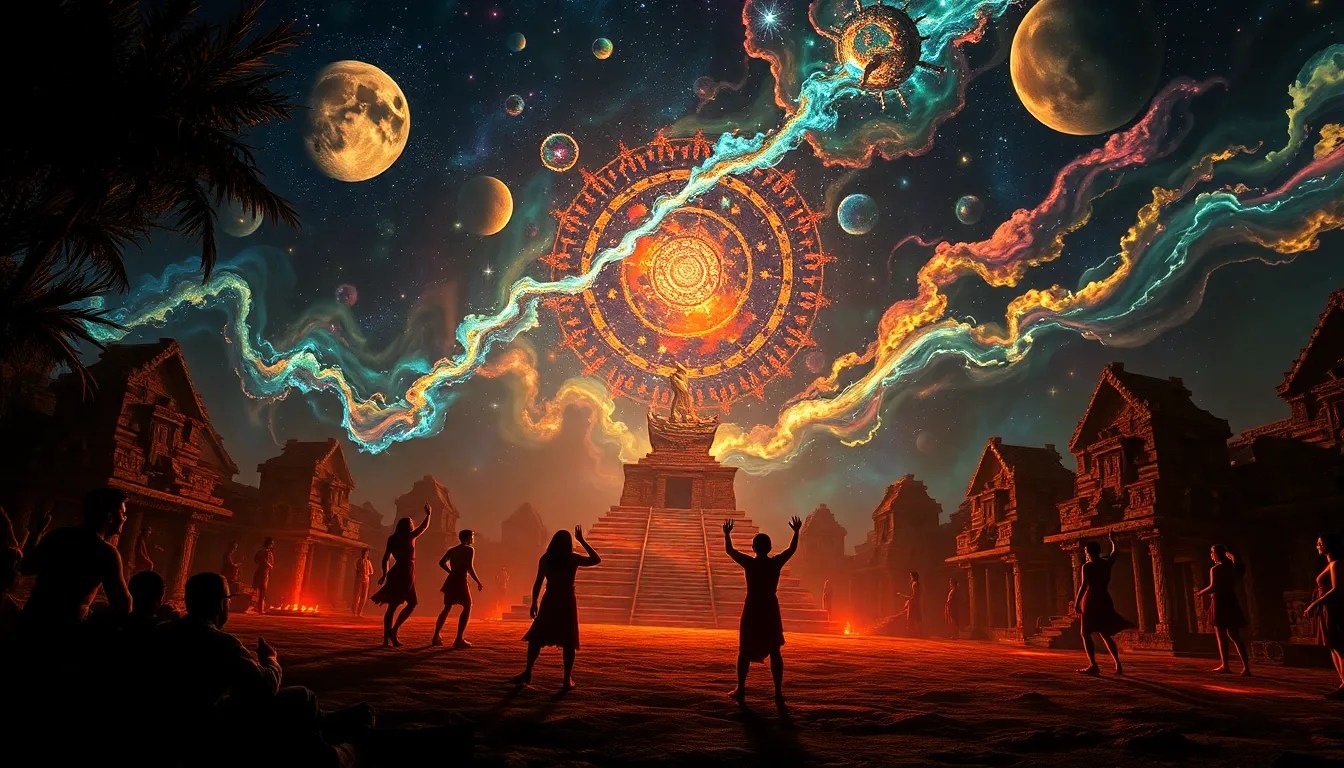The Cosmic Dance: How Mayan Myths Explain the Universe
I. Introduction
Mayan mythology is a rich tapestry of stories and beliefs that speak to the origins of the universe and humanity’s place within it. The ancient Maya, who thrived in Mesoamerica, crafted complex narratives that explain not only the creation of the world but also the cyclical nature of existence. Their understanding of the cosmos is deeply intertwined with their daily lives, agricultural practices, and spiritual rituals.
The concept of the cosmos in Mayan beliefs is not merely a backdrop for human activity; it is a dynamic entity that influences every aspect of life. The universe is seen as a living organism, with gods and celestial bodies playing crucial roles. This article delves into how Mayan myths elucidate the universe, offering insights into their creation stories, celestial deities, and the intricate relationship between time and nature.
II. The Creation Myths: Birth of the Cosmos
At the heart of Mayan cosmology lies the Popol Vuh, a sacred text that recounts the creation of the world and the origins of humanity. According to this myth, the universe began in a state of darkness and silence, and the gods, particularly Tepeu and Gucumatz, decided to create the world.
- The Popol Vuh: This text narrates the creation of land, animals, and finally, humans, who were made from maize, a sacred plant.
- Role of gods: The gods shaped the universe with their words and intentions, demonstrating the power of creation through thought and speech.
The symbolism of the cosmic tree, often depicted as a ceiba tree, represents the connection between the heavens, earth, and the underworld. It is a vital axis mundi that holds the universe together, while the four corners of the world symbolize the cardinal directions, each associated with different gods and elements.
III. The Celestial Bodies: Gods and Their Movements
The Maya had a profound understanding of celestial bodies, particularly the Sun, Moon, and Venus, which they associated with various gods and divine narratives. These bodies were believed to influence not just the cosmos but also human life.
- The Sun: Represented by the god Kinich Ahau, the Sun was vital for growth and life, emphasizing the cyclical nature of day and night.
- The Moon: Ix Chel, the Moon goddess, was associated with fertility and medicine, embodying the duality of life and death.
- Venus: The planet Venus was linked to war and conflict, often associated with the god Kukulkan.
Celestrial events, such as eclipses and the movements of these bodies, were believed to influence agricultural and social practices. For instance, the timing of planting and harvesting was often aligned with the cycles of the Moon and the Sun, demonstrating the Maya’s deep connection to the cosmos.
IV. Time and the Calendar: The Mayan Understanding of Cycles
The Maya had a sophisticated understanding of time, encapsulated in their calendars, primarily the Tzolk’in and Haab’. The Tzolk’in, a 260-day calendar, was used for ceremonial purposes, while the Haab’ was a solar calendar of 365 days.
- Cyclical time: The Maya viewed time as cyclical rather than linear, with events repeating in a cosmic rhythm.
- Cosmic force: This cyclical nature reinforced the idea that time itself was a living force that governed the universe.
Myths surrounding these calendars often emphasized the importance of rituals performed at specific times, underlining the belief that human actions were intertwined with cosmic cycles.
V. The Underworld: Xibalba and the Duality of Existence
Xibalba, the Mayan underworld, is a crucial aspect of their cosmology, representing a realm of both fear and reverence. It is depicted as a dark, labyrinthine place where the dead undergo trials before reaching the afterlife.
- Journey to Xibalba: The Popol Vuh recounts the journey of the Hero Twins, Hunahpú and Xbalanqué, who faced various challenges in Xibalba, highlighting the duality of life and death.
- Balance between life and death: This journey reflects the Mayan belief that life and death are not opposites but parts of a continuous cycle, integral to the cosmic dance.
The myths surrounding Xibalba emphasize the importance of balance and the understanding that existence encompasses both light and darkness.
VI. The Role of Nature: Earth, Sky, and the Elements
Mayan mythology is deeply rooted in the interconnectedness of nature and the cosmos. The elements—earth, sky, water, and fire—are often personified and revered in various myths.
- Animals and plants: Many Mayan myths feature animals and plants as central characters, reflecting their significance in the ecosystem and the universe.
- Rituals: Rituals were performed to honor the earth and sky, ensuring cosmic harmony and thanking the gods for natural cycles.
This interconnectedness highlights the Maya’s belief in the sacredness of nature and its vital role in the cosmic order.
VII. The Legacy of Mayan Cosmology: Influence on Culture and Society
Mayan myths profoundly shaped their civilization, influencing art, architecture, and social practices. Temples and pyramids were often aligned with celestial events, reflecting their cosmological beliefs.
- Cultural impact: Myths provided a framework for understanding the world, guiding moral values, and social structures.
- Modern interpretations: Today, there is a resurgence of interest in Mayan mythology, with scholars and enthusiasts exploring its relevance in contemporary society.
The enduring legacy of Mayan cosmology continues to inspire and inform our understanding of the universe.
VIII. Conclusion
The cosmic dance of Mayan mythology offers profound insights into the universe and our place within it. Through creation myths, celestial narratives, and the understanding of time and nature, the Maya crafted a worldview that emphasized interconnectedness and balance.
These ancient stories remain relevant today, reminding us of the complex relationships that exist within the cosmos. As we explore the depths of Mayan heritage, we invite readers to connect with these timeless myths and reflect on their significance in understanding our own universe.



